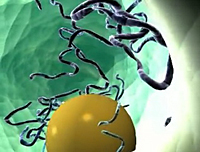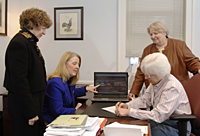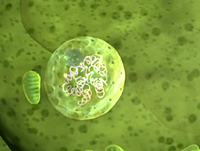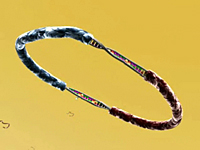

UDaily is produced by the Office of Public Relations
The Academy Building
105 East Main St.
Newark, DE 19716-2701
(302) 831-2791
|
 |
UD team creates video animation about recombinant DNA
Click here to see the video animation.
 |
| Illustration of a microscopic gold particile releasing recombinant DNA into a plant cell. |
3:32 p.m., March 22, 2006--A team of University of Delaware faculty and staff has developed video animation to demonstrate the process of developing a transgenic plant. The nine-minute video is an excellent way to enhance the understanding of something students cannot otherwise see, Lesa Griffiths, professor of animal and food sciences and director of the Center for International Studies, said.
Griffiths and Sherry Kitto, professor of plant and soil science, who teach the course, began the animation project in 2000 when they applied for and received a student technology assistant grant through the PRESENT, or Practical Resources for Educators Seeking Effective New Technologies, UD's teaching, learning and technology center.
With that grant and with technical assistance from the PRESENT, they developed an animation that evolved over the years from simple cartoon figures to high quality, full color video.
 |
| Gene-splicing animation team members (from left): Sherry Kitto, professor of plant and soil science; Lesa Griffiths, professor of animal and food sciences and director of the Center for International Studies; Pat Barber (seated), associate professor of food and resource economics; and Sue Snider, professor of animal and food sciences. |
Griffiths said the team used the preliminary animation to submit a successful grant proposal for a $100,000 Higher Education Challenge Grant from the U.S. Department of Agriculture to develop a more sophisticated animation and an associated web page with information on ethics and other aspects of recombinant DNA.
“The animation is a way to take a complex, active biological process and clearly show the process 'live,'” Kitto said. “Biological processes that take place at the molecular level are not visible, but this animation can show what is going on at the molecular level. The learner can 'see' what is going on at that level.”
"Designed correctly, a controllable animation can simplify and, therefore, clarify visualization of a complex concept," team member Kathie Troutman, associate director of IT-University Media Services, said. "The student has control to step through frames, or segments can be replayed until the student understands the process."
Becky Kinney, who was a graduate assistant when the project started and is now a multimedia specialist with the PRESENT, helped develop the original animation in cooperation with Christina Williams, then a senior and now a UD graduate student in plant molecular biology.
 |
| Illustration of a cell containing the genetic material, DNA |
Other members of the team are Pat Barber, associate professor of food and resource economics, who assessed the project; Sue Snider, professor of animal and food sciences, who provided Extension expertise; Micah Fegley, IT-University Media Services, who developed the animation; Paul Rickards, IT-University Media Services, the web site programmer; Ralph Begleiter, Edward F. and Elizabeth Goodman Rosenberg Professor of Communication, who provided the voice and advice on user-friendly language; John Pesek, assistant professor of food and resource economics, who analyzed the data from focus groups and student surveys; and Lisa Ahramjian, an undergraduate animal science major in the class of 2002, who designed the story board.
The four-year project included input from student focus groups on the early versions of the animation, the final animation, development of the rest of the website, assessment and evaluation, and distribution of the final product, Griffiths said.
 |
| Illustration of complementary sticky ends of plant DNA annealed with bacterial plasmid DNA, creating recombinant DNA. |
“Based on evaluations, students significantly improved their knowledge as a result of watching the video,” Snider said. “Overall, participants thought the animation was easy to follow and gave step-by-step information. They indicated that the three dimensional aspect helped them picture the process.”
“We are thrilled when the projects that are begun with PRESENT staff have such an impact that faculty can get further funding to extend their ideas,” Janet DeVry, director of the PRESENT, said. Faculty interested in learning how technology can enhance student learning are encouraged to contact the PRESENT at 831-0640 or via email at [present-site@udel.edu].
Article by Martin Mbugua
Photo by Kathy F. Atkinson
 E-mail this article
E-mail this article
 Subscribe to UDaily Subscribe to UDaily
 Subscribe to crime alert e-mail notification Subscribe to crime alert e-mail notification
|
 |

|

